ASCE Statement on the Build America Investment Initiative
July 17th, 2014 | By: Becky Moylan
Washington, D.C. — The following is a statement from Randall (Randy) S. Over, P.E., F.ASCE, president, ASCE on the Build America Investment Initiative: “Today’s action by President Obama to launch the Build America Investment Initiative comes at a critical time as we witness Congress still debating how to provide a long-term, sustainable solution to the federal Highway Trust Fund. While private sector financing can by no means replace public funding, states and localities urgently need all of the best tools available to provide transportation solutions for their communities. “The newly-created Build America Transportation Investment Center can play a vital role in sharing best public-private partnerships (P3s) practices and encouraging more states to utilize P3s to a greater degree, thereby creating a more robust U.S. market and attracting private sector investment in our nation’s transportation infrastructure. “ASCE looks forward to working with the Obama Administration to positively implement this action in the coming weeks and months. ASCE supports a comprehensive funding and financing program for operating, maintaining, and improving the nation’s transportation system, which includes P3s, infrastructure banks, bonding and other innovative financing mechanisms. If utilized appropriately, these financing mechanisms can help leverage available transportation funding and play an important role in delivering projects and managing assets effectively.”###
Founded in 1852, the American Society of Civil Engineers represents more than 145,000 civil engineers worldwide and is America’s oldest national engineering society. For more information, visit www.asce.org.Tags: ASCE, bridges, Build America Investment Initative, congress, highway trust fund, infrastructure, P3s, roads, surface transportation, White House
No Comments »
5 Graphics Every Pennsylvania Driver Should See
July 17th, 2014 | By: Infrastructure Report Card
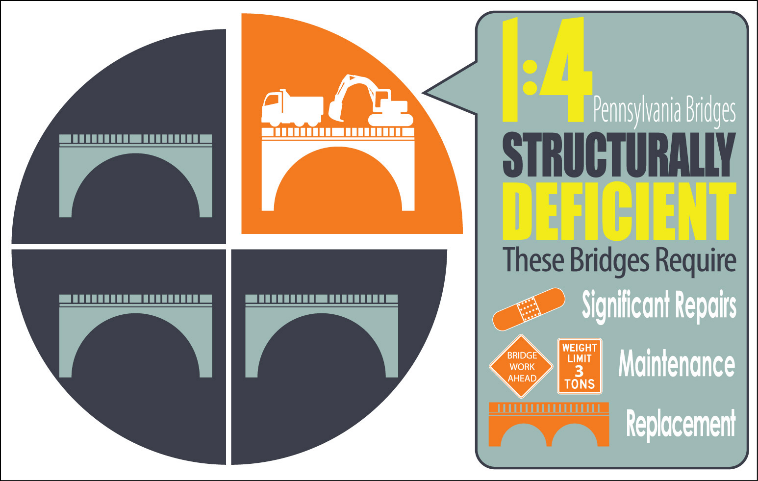
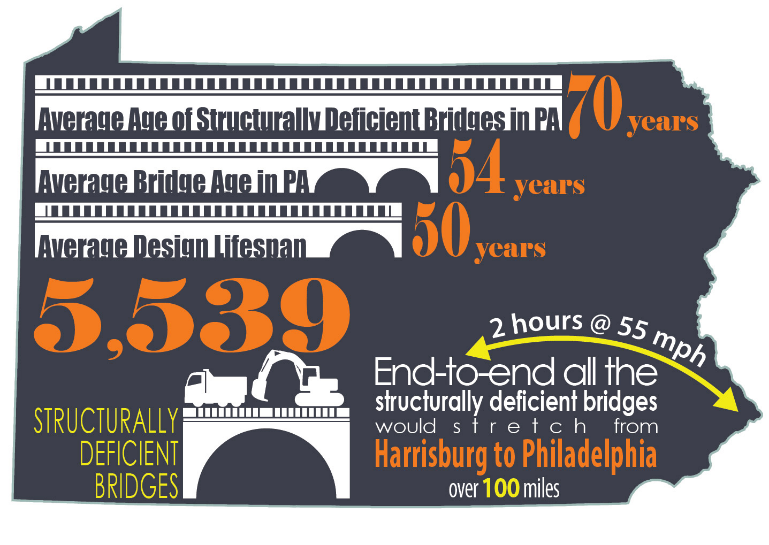
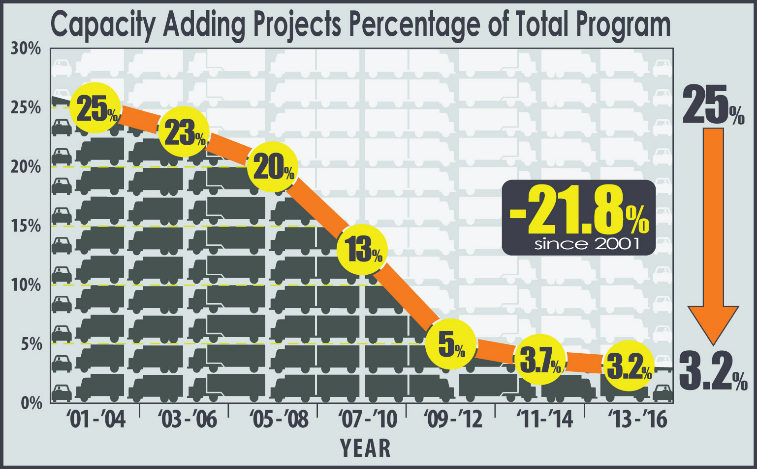
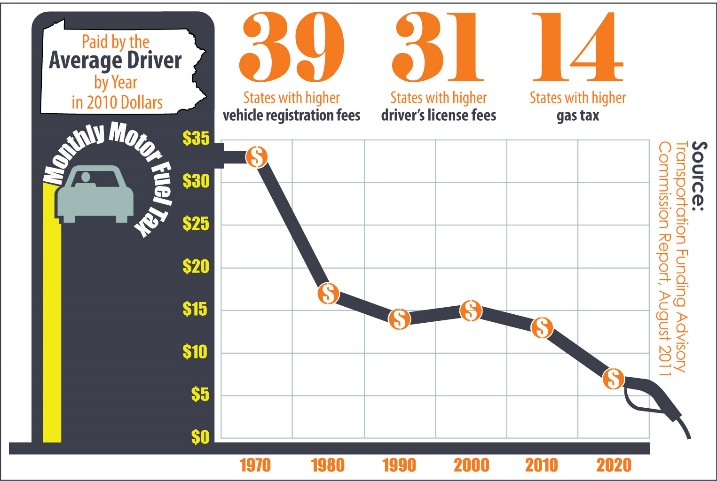
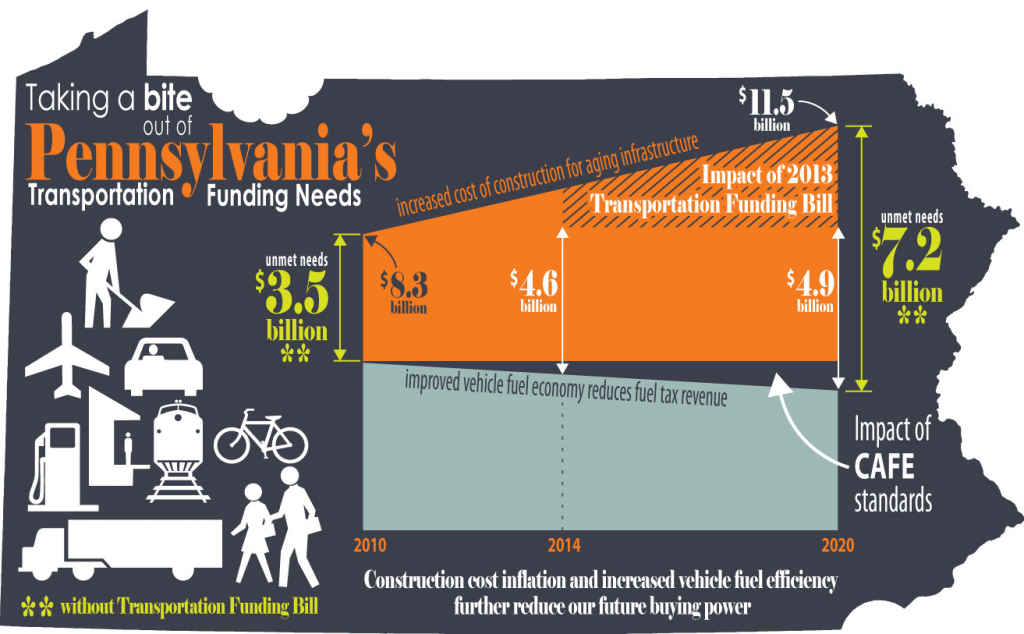 In 2013, Pennsylvania stepped up to start addressing these problems with a transportation funding package, but even with it, there’s still more work to be done than the funding that’s available. Also, if Congress fails to come up with their promised funding by the end of August, this could set Pennsylvania back in spite of trying to catch up on their transportation needs. Pennsylvania has done their part, Congress should really get to work on theirs.
Want to find out more about Pennsylvania’s other infrastructure? Start with the 2014 Report Card for Pennsylvania’s Infrastructure!
Images created by Jason Forbes of McCormick Taylor
In 2013, Pennsylvania stepped up to start addressing these problems with a transportation funding package, but even with it, there’s still more work to be done than the funding that’s available. Also, if Congress fails to come up with their promised funding by the end of August, this could set Pennsylvania back in spite of trying to catch up on their transportation needs. Pennsylvania has done their part, Congress should really get to work on theirs.
Want to find out more about Pennsylvania’s other infrastructure? Start with the 2014 Report Card for Pennsylvania’s Infrastructure!
Images created by Jason Forbes of McCormick Taylor
Tags: #fixthetrustfund, bridges, congress, Pennsylvania, report card
No Comments »
ASCE Statement on the House Plan to Maintain the Highway Trust Fund for Only 9 More Months
July 15th, 2014 | By: America's Infrastructure Report Card
Washington, D.C. —The following is a statement from Patrick Natale, P.E., Executive Director of The American Society of Civil Engineers (ASCE) on the passage of H.R. 5021 in the U.S. House of Representatives: “Today, the U.S. House of Representatives averted an immediate economic disaster by addressing the impending insolvency of the Highway Trust Fund. Regrettably, their efforts also created a new, looming disaster next May. Punting on America’s infrastructure deficit will not fix the problem, and in fact will only create greater economic uncertainty. Congress needs to get serious about America’s future rather than creating more unnecessary turmoil. “America’s businesses, laborers, engineers, and manufacturers have been urging Congress for well over a year to find a long-term, sustainable solution to our country’s surface transportation issues. States and cities cannot plan for the future if funding is only going to be approved on a crisis by crisis basis. Imagine the challenges of building your home if you were unaware of where your money was coming from or when you could use it—that is the current case for America’s infrastructure. “The band-aid put on the Highway Trust Fund today ensures that we must limp along rather than take proactive steps to create a solid economic foundation. By maintaining current funding, we are solidifying funding levels that have given the U.S. an infrastructure grade of D+ in ASCE’s Report Card for America’s Infrastructure. Does Congress not think America deserves better than a barely passing grade? “This moment is the best opportunity in a generation to solve America’s infrastructure deficit. Now is the time for a renewed investment in our nation’s infrastructure. We need bipartisan leadership from Congress and the White House to pass a long-term, reliable funding solution that will give states and cities the ability to plan for the future.”###
Founded in 1852, the American Society of Civil Engineers represents more than 145,000 civil engineers worldwide and is America’s oldest national engineering society. For more information, visit www.asce.org.
Tags: ASCE, bridges, congress, highway trust fund, roads, surface transportation, transportation
No Comments »
Meet IP3, the New P3 Where Citizens Are the Owners
December 19th, 2013 | By: Infrastructure Report Card
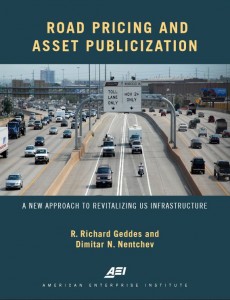 If you follow the infrastructure financing debate about how America is going to fund our future infrastructure needs, you have probably heard the term P3 or public-private partnership discussed as an innovative financing structure to utilize private investment in public infrastructure. However, with the release of the American Enterprise Institute’s new report, Road Pricing and Asset Publicization,” there is a new angle for the debate – the investment public-private partnership (IP3).
So what exactly is this IP3? Here’s how the report’s authors explain it: “The IP3 recognizes that you not the federal government or a private company—own roads that have already been built. And it offers you an annual payment for investing in them…. Under an IP3, a private company pays a public partner (like a state) a large upfront cash payment (called a concession) for the right to operate and collect toll revenue from an existing road network for a certain period of time. The IP3 locks away most of that concession payment—and most of the toll revenue—in a protected investment fund that pays an annual dividend to all households in the newly priced region. That helps offset the additional costs they will face from tolls, while recognizing that citizens are the true owners of the roads.”
America’s roads are definitely in need of repair so the more new ideas that are debated that’s all the better including P3s, gas tax changes and fixes, and all the others. While P3s are only one potential solution among the many, one thing is for certain – it’s time to start debating before the Highway Trust Fund is broke and many states lose half of their highway and bridge funding.
If you follow the infrastructure financing debate about how America is going to fund our future infrastructure needs, you have probably heard the term P3 or public-private partnership discussed as an innovative financing structure to utilize private investment in public infrastructure. However, with the release of the American Enterprise Institute’s new report, Road Pricing and Asset Publicization,” there is a new angle for the debate – the investment public-private partnership (IP3).
So what exactly is this IP3? Here’s how the report’s authors explain it: “The IP3 recognizes that you not the federal government or a private company—own roads that have already been built. And it offers you an annual payment for investing in them…. Under an IP3, a private company pays a public partner (like a state) a large upfront cash payment (called a concession) for the right to operate and collect toll revenue from an existing road network for a certain period of time. The IP3 locks away most of that concession payment—and most of the toll revenue—in a protected investment fund that pays an annual dividend to all households in the newly priced region. That helps offset the additional costs they will face from tolls, while recognizing that citizens are the true owners of the roads.”
America’s roads are definitely in need of repair so the more new ideas that are debated that’s all the better including P3s, gas tax changes and fixes, and all the others. While P3s are only one potential solution among the many, one thing is for certain – it’s time to start debating before the Highway Trust Fund is broke and many states lose half of their highway and bridge funding.
Tags: bridges, infrastructure, infrastructure report card, P3, roads, surface transportation, transportation
1 Comment »
The Countdown Begins – Our Federal Funding for Transportation May Run Dry Next Year
December 18th, 2013 | By: America's Infrastructure Report Card
Transportation is a key issue in 2014 as the Highway Trust Fund will be insolvent by 2015 and MAP-21 is set to expire in September. In some states, transportation projects are already being put on hold because of the uncertainty of future federal funding. The UPDATE Act introduced by Rep. Earl Blumenauer (D-OR) is just one of several current proposals regarding infrastructure funding supported by ASCE. To date, the motor fuels user fee (gas tax) has proven to be an efficient, reliable, and fair method of funding our nation’s surface transportation programs. At present, the federal motor fuels tax generates revenues that are reserved for investment in highway and public transportation improvements through the Highway Trust Fund. However, the 18.4 cents per gallon federal gas tax has not been adjusted since 1993 and has lost one-third of its purchasing power over the last 17 years. According to the Consumer Price Index, the costs of many household items have nearly doubled over the last 20 years. Some examples include:- A loaf of bread: 1993: $0.75, 2013: $1.41
- A pound of coffee: 1993: $2.50, 2013: $5.21
- A new car: 1993: $12,750, 2013: $31,252
Tags: bridges, congress, gas tax, highway trust fund, roads
No Comments »
Government Shutdown Highlights U.S. Inability to Solve Big Problems as Gas Tax Reaches 20th Anniversary
October 1st, 2013 | By: America's Infrastructure Report Card
Reston, Va. — The following is a statement from Gregory E. DiLoreto, P.E., P.L.S, D.WRE, president of The American Society of Civil Engineers (ASCE), regarding the current government shutdown and the 20th anniversary of the last federal gas tax increase: “Today marks the 20th anniversary since the federal gas tax was last raised to 18.4 cents per gallon in 1993. With the government shutting its doors today, this is a reminder of the pressing need for bipartisan solutions to America’s largest problems. “The shutdown of the federal government will have long-lasting negative effects on America’s already outdated infrastructure. With national parks closed, repair and replacement projects will be put on hold while parks lose needed revenue. We have furloughed one-third of the U.S. Department of Transportation employees, hurting our ability to asses, plan, and respond to needed surface transportation issues. This short-sighted shutdown creates economic uncertainty and halts continuing planning, forcing infrastructure projects to use stop-gap measures for long-term needs. “Regrettably, the shutdown is nothing new. The 20th anniversary of the federal gas tax shows that Congressional inaction has for far too long hurt American families and business. Given the growth and expansion of the U.S. over the last 20 years, one has to wonder the consequences of funding our 2013 infrastructure with 1993 dollars. “According to the Consumer Price Index, the costs of many household items have nearly doubled over the last 20 years. Some examples of the price differences between 1993 and today include:- A loaf of bread: 1993: $0.75, 2013: $1.41
- A pound of coffee: 1993: $2.50, 2013: $5.21
- A new car: 1993: $12,750, 2013: $31,252
This Week’s Top 5 Infrastructure Stories
September 6th, 2013 | By: America's Infrastructure Report Card
ASCE Report Card Chair Writes for PBS on Infrastructure’s Present and Future Expanding cities, global businesses, and an interconnected world mean that people need to travel to more places than ever before. Cities cannot prosper in isolation, and businesses cannot thrive if they cannot move goods effectively. As our nation continues to grow, so too must our basic infrastructure. Today, our roads, bridges, and transit systems are not keeping pace with America’s rapid change—meaning we are not positioning ourselves for the future. Maine House Majority Leader Backs Infrastructure Investment Maine wins when we make smart investments in our future. The recent State House approval of a bipartisan jobs and infrastructure bond package was just such a win. Looking ahead, we must next consider funding for research and economic development. Afraid of Heights!: Man Looks for Scariest Bridges The United States has seen a golden age of magnificent bridges built since the 1930s, O’Donnell says, and now the nation will likely focus on maintenance. Transportation and civil engineering groups have been warning for years about the consequences of neglecting U.S. bridges. Chair of House Transportation and Infrastructure Committee Rides the Future Google’s not the only entity testing self-driving cars on actual US roads. Today, Bill Schuster (R-PA), the congressman who chairs the House Transportation and Infrastructure Committee, took a 33-mile trip in an autonomous vehicle built by Carnegie Mellon University and funded by General Motors. The 2011 Cadillac SRX ferried the Pennsylvania congressman from the town of Cranberry to Pittsburgh International Airport earlier this morning, while a cameraman broadcast his journey to the web. Infographic: Commuters Have Changed, So Must Our Infrastructure The percentage of U.S. workers who drove to work in a private vehicle grew from 62.7 percent in 1960 to 84.4 percent in 2011, according to Census Bureau data. Only around 9 percent commuted using a carpool in 2011, half the percentage of workers that carpooled in 1980.I-35 W: Six Years After the Bridge Fell
August 1st, 2013 | By: America's Infrastructure Report Card
On August 1, 2007, the I-35 W span over the Mississippi River collapsed, killing 13 people, injuring 145, and severing a vital lifeline for many towns. Only 382 days later, the bridge had been replaced and was open to traffic once again. Six years after this tragedy, the question remains whether we have done enough to repair our crumbling infrastructure. Success stories like the rapid reconstruction of the I-35 bridge are widely touted, but isolated incidents are needed less than general trends toward improvement. In an analysis of the nation’s roads and bridges, 1 out of 9 is deemed “structurally deficient”, while in five individual states, more than 20 percent of bridges are rated as such. Since 2000, 22,711 bridges are no longer considered structurally deficient. While this is an improvement, there are concerns that fiscal realities may derail progress. Currently, the Highway Trust Fund is projected to become insolvent in September of next year. The HTF is the primary means by which many states fund infrastructure repair and replacement projects. The I-35 replacement was constructed so quickly in large part due to near-continuous work for 11 months. Without adequate funding for construction projects, the time for completion will lengthen, driving up costs and the impacts on drivers. Bridges are indispensable parts of our infrastructure system. Without safe, reliable, and efficient transportation, we will see the toll taken on the prices of goods and costs to ourselves and others. The average age of the 600,000 bridges in this nation is 42 years, with an estimated $76 billion in needs to address the problems. ASCE’s Failure to Act report on the costs of poor infrastructure shows that by 2020, deficient bridges and pavement will cost Americans 58 billion. If left untended, those costs will jump to $651 billion by 2040. So as we approach the 6th anniversary of the terrible happenings on the I-35 W bridge, foremost in our mind should be the state of our infrastructure and if we are really doing enough to maintain our bridges. Individual instances of rapid repair and replacement are necessary, but insufficient. We must continue to fund the Highway Trust Fund and provide governments at all levels the tools they need to keep our infrastructure standing.Get to Know North Carolina’s Mediocre Infrastructure
June 5th, 2013 | By: America's Infrastructure Report Card
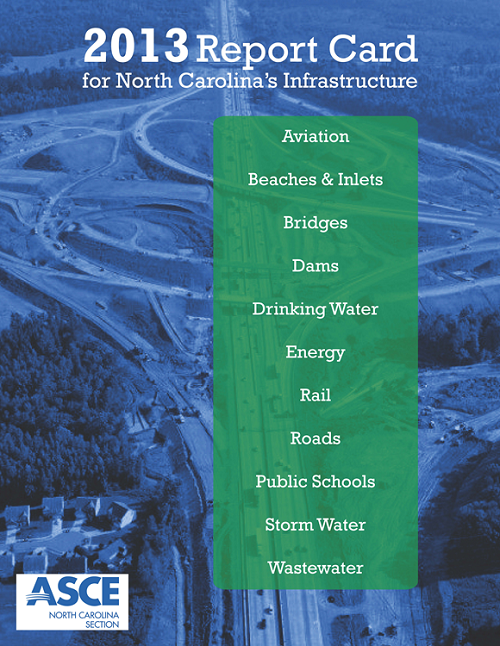 Today, North Carolina’s civil engineers released a new Infrastructure Report Card. After spending a year diving into the details of the state’s infrastructure – from bridges to beaches to dams – they determined that North Carolina’s infrastructure only deserved a mediocre C grade. Like many areas of the country, North Carolina has some work to do to make sure maintenance gets done, aging parts of the system get a modern overhaul, and the infrastructure keeps up with the state’s growth.
The state-wide report examined eleven categories of infrastructure, grading their capacity, resiliency, funding, and reliability. Here’s what they found:
Today, North Carolina’s civil engineers released a new Infrastructure Report Card. After spending a year diving into the details of the state’s infrastructure – from bridges to beaches to dams – they determined that North Carolina’s infrastructure only deserved a mediocre C grade. Like many areas of the country, North Carolina has some work to do to make sure maintenance gets done, aging parts of the system get a modern overhaul, and the infrastructure keeps up with the state’s growth.
The state-wide report examined eleven categories of infrastructure, grading their capacity, resiliency, funding, and reliability. Here’s what they found:
- Aviation earned a D+, in part due to an estimated $763 million needed to bring all airports in the system to a state of good repair.
- Beaches and Inlets were awarded a C-. Many shoals and inlets are functioning at significantly less than authorized depths. Continued erosion of federal and state funding has a significant impact N.C.’s beaches and inlets.
- Bridges earned a C-. North Carolina’s bridges require $281 million more per year in order to make significant strides in raising the grade of North Carolina bridges.
- Dams earned the lowest grade of a D. Ten percent of North Carolina’s high hazard dams are deficient and only 34 percent have Emergency Action Plans. One-third of North Carolina’s dams are over 50 years old.
- Drinking Water earned a C+. North Carolina has over 530 public water systems which serve approximately 7.3 million North Carolinians (75 percent of the state’s population).
- Energy was awarded the highest grade in the report of a B+. North Carolina has a solid foundation of energy and energy infrastructure to meet its current and 20-year planning horizon needs.
- Rail earned a C+, in part due to only 30 percent of the state’s short lines being able to accommodate new, heavier rail cars. It is estimated that freight rail investment needs over the next 25 years will total $545 million.
- Roads earned a C. The scale of the state maintained highway network, current economic circumstances, and the trend of reducing the state transportation agency’s resources and personnel have been challenges to providing and maintaining a sustainable quality of service.
- Schools earned a C. Over 58 percent of North Carolina schools will require renovations in the next five years. Additionally, approximately 10 percent of students are in mobile classrooms. The projected cost to meet facility needs for the next five years is approximately $8.2 billion.
- Stormwater earned a grade of C-. Most of North Carolina’s population lives in communities that have no dedicated source of funding to improve stormwater quality. Statewide sources of funding such as the N.C. Clean Water Management Trust Fund are being reduced and North Carolina’s communities have fewer and fewer options when trying to address their stormwater improvement needs.
- Wastewater earned a C. North Carolina has documented a need of over $4 billion of additional wastewater infrastructure investment needs through the year 2030. These funds are needed to replace aging facilities, comply with mandated Clean Water Act regulations, and keep pace with economic development.
Tags: bridges, continuing education, dams, energy, infrastructure, infrastructure report card, ports, rail transportation, roads, state report cards, transportation, wastewater, water infrastructure
No Comments »



 */ ?>
*/ ?>











